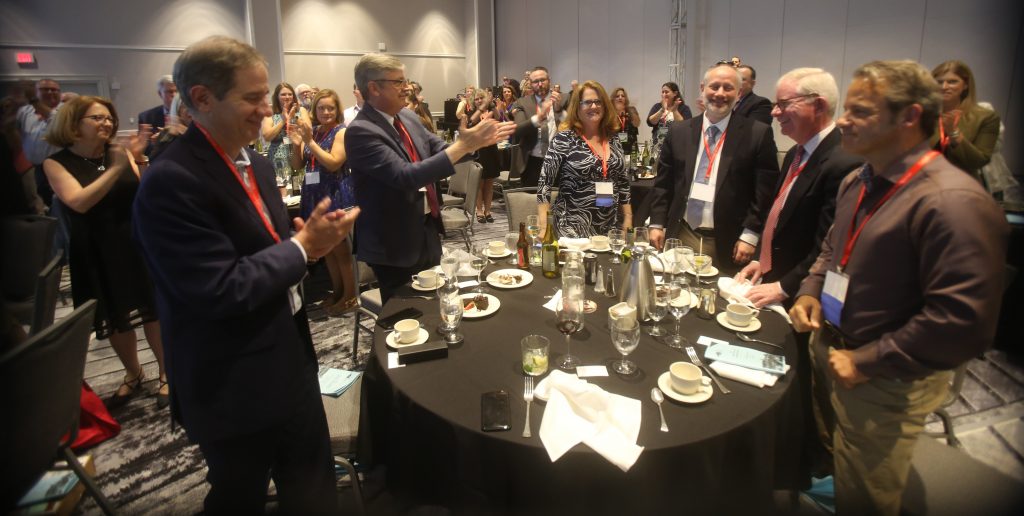On the hallway wall leading to my office at Catholic News Service is arrayed a series of eight photographs of its previous directors.
Justin McGrath, the first director, guided the service from 1920 to 1931. Frank Hall, with the longest tenure, led the service from 1932 to 1963. The most recent photos include Richard Daw, Tom Lorsung and Tony Spence.
I pass those photos every day, a very personal reminder not only of the more than 100 years that the news service has been in existence, but that it has been staffed by flesh and blood, men and women who dedicated themselves to being the news service of record.
From manual typewriters to cellphones, they documented the events and the people that made up the church in this country for the past century: Our first Catholic presidential candidate in 1928. Our first Catholic president in 1960. The Second Vatican Council and all the changes that followed. The civil rights movements. The wars. The papacies.
CNS was originally founded by editors before the bishops' conference assumed responsibility for it in 1920. It evolved over the decades, expanding its coverage of the Vatican into a full-fledged bureau in 1950, a fortuitous decision in advance of the dramatic events of Vatican II.
In the council's wake, the documentary service Origins was established. It became a necessary resource for understanding the changes emanating from Rome as well as the great debates of the U.S. bishops themselves as they hammered out the war and peace pastoral, the economics pastoral, and, later, their repeated efforts to address the sexual abuse crisis.
In all of its coverage, CNS amplified not only the voices of the popes, but also those of the bishops and lay leaders of the church in America, giving them an international audience and an international influence.
Along with the reporting, the news service kept pace with technology, introducing the photo service, then digital services, video, and most recently podcasts as its clients' needs grew and changed.
What did not change was that the work of reporting, editing, photographing and filming has always been done by men and women who committed themselves to doing the best job possible to get the story and to get it right.
The list of editors and reporters who have worked for CNS is long and noteworthy. Less known but also deserving of note are the interns and reporters who were "graduates" of CNS, taking their skills to other organizations in the Catholic press, helping to spread a culture of professionalism and dedication to the craft of Catholic journalism.
Many of them, like myself, dedicated the better part of their professional lives to communicating the faith lived out in practice, documenting the church's engagement with the great issues of the day, and telling the stories of ordinary and extraordinary Catholics who were the face of that church.
This is noble, necessary work. For most of us it is at once a profession, a career, a vocation, a mission. It melds, whether we want it to or not, our professional life with our faith life. It is a spiritual double helix of the personal and the professional that becomes part of our DNA.
Journalists are by stereotype a pretty cynical group. They've seen the sausage being made. They shed a lot of their illusions. But to combine faith and career is personal and at times even fragile. To put 20 or 30 or 40 years into this effort is a vocation lived out in service to the people of God as certainly as that of any priest or bishop or deacon.
The news that CNS would be forced to shutter its Washington and New York offices at the end of 2022 was greeted with shock and dismay.
But the truth is, we've seen a disturbing number of Catholic news staff -- diocesan and national -- laid off in recent months and years. Some of the most historic or most acclaimed Catholic newspapers have been shut down. People are dismissed with little recognition of their service. "We've been kicked to the curb," is an oft-heard complaint.
That businesses, even church businesses, run into financial pressures is nothing new. That management decides, rightly or wrongly, that another media strategy is necessary is nothing new, either.
I think it is fair to say that collectively the church as an institution doesn't handle these kinds of transitions well. Perhaps that's because of a certain clericalism, or the notion that the church knows best. Perhaps it is a bit of guilt, people representing an institution big on mercy and supporting workers are uneasy about tossing people out of jobs.
But for a moment let us, in the words of W.H. Auden, "Stop all the clocks, cut off the telephone" and salute not just the staff of CNS, but all of those extraordinary editors, reporters, designers, ad managers and more who have lost their jobs these past few years.
Let us acknowledge that these are men and women, flesh and blood, who worked long hours and weekends, who made sacrifices, who went above and beyond when necessary, and who did their level best to report the news and serve their readers even as budgets were cut and staffing eroded.
Let us remember not just the 14 employees of CNS, but also those of Catholic New York, the Catholic Sentinel, the Catholic Miscellany, the Pittsburgh Catholic, and so many other newspapers who were dedicated to recording the first draft of our Catholic history.
To our colleagues, our peers, our clients, our friends, yours has been a noble work.
May the spirit of our profession continue in the work of the CNS Rome bureau, in the work at OSV News, and in the work of all the Catholic journalists who will continue to serve the church they report on in the coming years.

